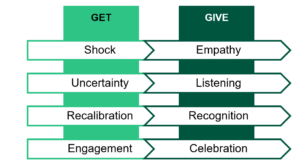Lead Yourself (Before Leading Others) In Volatile Times
Things are crazy right now: The level of volatility in the market, politics, and our organizations threatens to overwhelm us into paralysis. And yet, as a leader, you are expected to lead others through it all. How well can you lead others when you are drowning in uncertainty? You can’t. Repressing your misgivings and presenting a facade to your team won’t work because people can smell inauthentic leadership from a mile away. You must take steps to restore your own optimism, confidence, and calm before your misgivings inspire panic in others.
To lead your people through volatility, first take the time to lead yourself. For example, here’s a framework that my colleague Katy Tynan created for her change leadership SURE model:

This framework was originally meant for leaders to use with their teams, guiding leaders to know what to “give” when they “get” certain responses from their people. But you can apply this same approach to yourself and restore your own calm and confidence:
- When you feel shock, give yourself empathy. Acknowledge your feelings, and tell yourself that it’s understandable and normal to feel this way. Accept it; don’t suppress it.
- When you feel uncertainty, listen to yourself. Explore your uncertainty with intent curiosity. Ask “What’s driving my uncertainty? What am I unsure about? What would help me feel more certain about things?” It’s the general fog of unspecific uncertainty that creates the most disruption. When you can pinpoint exactly what makes your confidence falter, you can take steps to address it.
- When you are ready to recalibrate, recognize that in yourself and give yourself a pat on the back for making that turn. Mark your mindset shift and congratulate yourself for starting a more positive flywheel of thoughts and behaviors.
- When you feel engaged and “in it,” celebrate your progress and success. Reward yourself for reengaging. Model your mindset shift and positive energy with others so that they see the benefits of engaging. Influencing their behavior will be the biggest reward of all. Now you’re ready to lead through change sustainably and authentically.
From my work in coaching, another tool that’s helpful in restoring confidence and reducing anxiety is the three-step process:
- Step 1. Recall a time when you were in a similar situation of uncertainty or doubt — feeling stuck, listless, whatever — and were still ultimately successful.
- Step 2. Ask yourself, “What about me [not the situation or related to someone else but a personal attribute about you] helped me be successful that time?”
- Step 3. Think to yourself, “How can I apply my [personal attribute that helped me be successful in the past] to my situation now?” Ta da. Now you’ve reminded yourself that no matter what knocks on your door next, you’ll be able to handle it because of who you are, your experience, your skills, and your unique gifts.
Take these simple steps to get your bearings first, like putting the oxygen mask on before then guiding others around you to do the same, using some of these same tools to restore their “oxygen.” I’d say good luck, but with good, mindful practices like these, you won’t need it! Let me know if I can help along the way.
